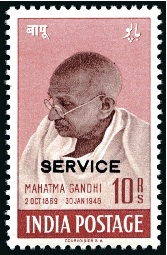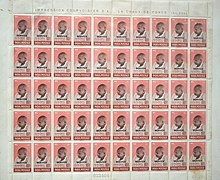
Indian postal systems for efficient military and governmental communications had developed long before the arrival of Europeans. When the Portuguese, Dutch, French, Danish and British conquered the Marathas who had already defeated the Mughals, their postal systems existed alongside those of many somewhat independent states. The British East India Company gradually annexed the other powers on the sub-continent and brought into existence a British administrative system over most of modern-day India, with a need to establish and maintain both official and commercial mail systems.
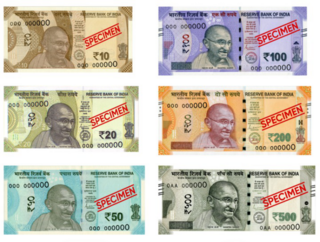
The Indian rupee is the official currency of India. The rupee is subdivided into 100 paise, though as of 2019, coins of denomination of 1 rupee are the lowest value in use. The issuance of the currency is controlled by the Reserve Bank of India. The Reserve Bank manages currency in India and derives its role in currency management on the basis of the Reserve Bank of India Act, 1934.

The Pakistani rupee is the official currency of Pakistan since 1948. The coins and notes are issued and controlled by the central bank, namely State Bank of Pakistan.

This is a survey of the postage stamps and postal history of Iraq. It includes special uses under the Ottoman Empire as well as occupation issues.
This is a survey of the postage stamps and postal history of British East Africa.

This is a survey of the postage stamps and postal history of Kuwait.

The history of the rupee traces back to ancient Indian subcontinent. The mention of rūpya by Pāṇini is seemingly the earliest reference in a text about coins. The term in Indian subcontinent was used for referring to a coin.

In general, philatelic fakes and forgeries are labels that look like postage stamps but have been produced to deceive or defraud. Learning to identify these can be a challenging branch of philately.

Postage stamps of Pakistan are those issued since Pakistan's independence in 1947. Pakistan Post has issued more than 600 sets and singles totalling more than 1300 stamps. Immediately after the independence of Pakistan in 1947, the new Pakistan government was preoccupied with setting up the government so British Indian stamps continued in use without an overprint as was the practice in other countries.
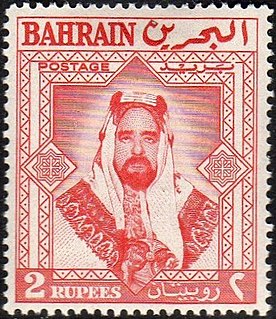
Bahrain first used the postage stamps of British India before eventually issuing its own stamps in 1960.

The Gandhi Series of banknotes are issued by the Reserve Bank of India (RBI) as the legal tender of Indian rupee. The series is so called because the obverse of the banknotes prominently display the portrait of Mahatma Gandhi. Since its introduction in 1996, this series replaced all Lion Capital Series banknotes issued before 1996. The Reserve Bank of India (RBI) introduced the series in 1996 with 10 and 500 rupee banknotes.

The Indian 1000-rupee banknote was a denomination of the Indian rupee. It was first introduced by the Reserve Bank of India in 1938 under British rule and subsequently demonetized in 1946. Post-independence, the denomination was re-introduced in 1954. In January 1978, all high-denomination banknotes of ₹1000, ₹5000, and ₹10000 were demonetized in order to curb unaccounted cash money.
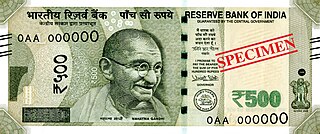
The Indian 500-rupee banknote is a denomination of the Indian rupee. In 1987, the ₹500 note was introduced, followed by the ₹1,000 note in 2000 while ₹1 and ₹2 notes were discontinued in 1995. The current ₹500 banknote, in circulation since 10 November 2016, is a part of the Mahatma Gandhi New Series. The previous banknotes of the Mahatma Gandhi Series, in circulation between October 1997 and November 2016, were demonetised on November 8, 2016.

The is a denomination of the Indian rupee. The present ₹50 banknote in circulation is a part of the Mahatma Gandhi New Series of banknotes. However, ₹50 banknotes of the previous series will continue to be legal tender.

The Indian 10-rupee banknote is a common denomination of the Indian rupee. The ₹10 note was one of the first notes introduced by the Reserve Bank of India as a part of the Mahatma Gandhi Series in 1996. These notes are presently in circulation along with the Mahatma Gandhi New Series which were introduced in January 2018, this is used alongside the 10 rupee coin.
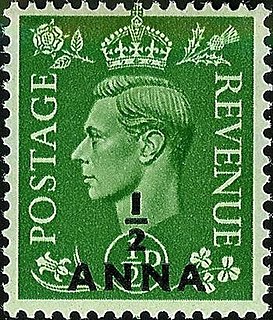
British postal agencies in Eastern Arabia issued early postage stamps used in each of Abu Dhabi, Bahrain, Dubai, Kuwait, Muscat and Qatar. Muscat and Dubai relied on Indian postal administration until 1 April 1948 when, following the Partition of India, British agencies were established there. Two agencies were opened in Qatar: at Doha and Umm Said. In Abu Dhabi, an agency was opened on Das Island in December 1960 and in Abu Dhabi City on 30 March 1963. The agencies also supplied stamps to Bahrain until 1960; and to Kuwait during shortages in 1951–53.

The Indian 2000-rupee banknote (₹2000) is a denomination of the Indian rupee. It was released by the Reserve Bank of India (RBI) on 8 November 2016 after the demonetisation of ₹500 and ₹1000 banknotes and has been in circulation since 10 November 2016. It is a part of the Mahatma Gandhi New Series of banknotes with a completely new design.

The Mahatma Gandhi New Series of banknotes are issued by the Reserve Bank of India (RBI) as the legal tender of the Indian rupee, intended to replace the Mahatma Gandhi Series of banknotes. Announced on 8 November 2016, it followed the demonetisation of ₹500 and ₹1000 banknotes of the original Mahatma Gandhi Series. Similar to the preceding series of banknotes, the obverse of the Mahatma Gandhi New Series banknotes also prominently displays the portrait of Mahatma Gandhi. The logo of Swachh Bharat Abhiyan is also printed on the back of the banknotes of this series.

